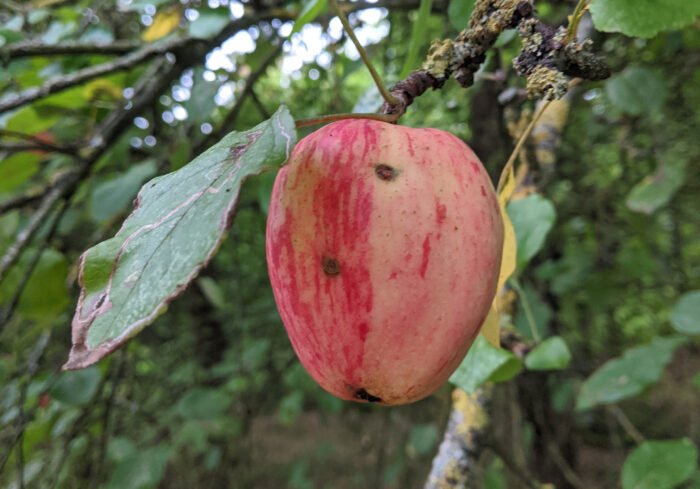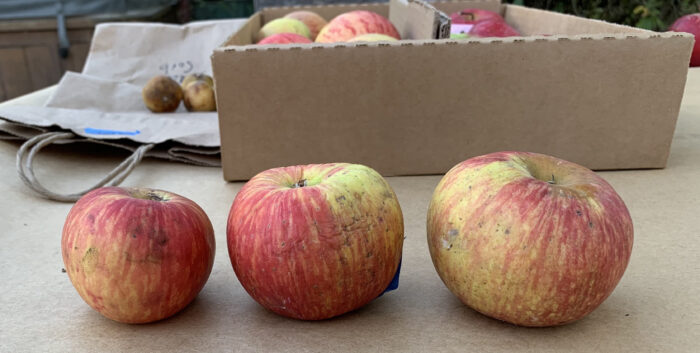
Foxwhelp. It’s sort of an odd name for an apple, if you think about it. No one really knows where the name came from, though in the 19th century some speculated that it was discovered by a hunter, growing near a fox den. It is a very old apple, mentioned by name in a number of mid-17th century English treatises on cidermaking. Apples were more typically cited by class, but Foxwhelp had already gained a reputation for making distinctive cider. As seems to happen with all famous apples, 200 years later there were any number of new arrivals bearing the Foxwhelp name–Bulmer’s Foxwhelp, Broxwood Foxwhelp, Black Foxwhelp, Red Foxwhelp, Rejuvanated Foxwhelp. How they related to the original wasn’t clear, though all seem to have found their way into some farmer’s cider barrels.
For all its reputation, Foxwhelp’s history in the U.S. is problematic. It crossed the Atlantic many times, it seems, but according to its DNA profile it turns out that the apple listed as ‘Foxwhelp’ in the official USDA apple collection in Geneva, NY, the source of scionwood for so many new orchards, is something quite unrelated, a Fauxwhelp.
The story of Foxwhelp’s arrival in the U.S. starts with William B. Alwood (1859-1946), Professor of Horticulture, Entomology, and Mycology at Virginia Polytechnic Institute and Vice-Director of the Virginia Agricultural Experiment Station (1888-1904). As the 20th century approached, there was some concern in government circles that American apples not fit for the fresh market were going to waste, and something needed to be done about it. Some of those “waste” apples went to cider, of course, but the sense was that there was room for improvement. Funding was found to send Alwood on a research trip to England, France, and Germany where he studied all aspects of cidermaking with the leading experts of the time. He returned with enough information to write several treatises and a collection of scionwood for some of Europe’s most popular cider-specific apples, including Foxwhelp. A report on activities at the Virginia Experiment station published in 1904 said that the apple was thriving, though it had not yet fruited.
All of the research work done by Alwood and his colleagues came to naught, though, as Prohibition loomed. Alwood moved on to other work. The apple varieties he collected were relocated to another federal research orchard in Maryland, then mostly vanished from the public mind.
Foxwhelp next officially arrived in 1939 courtesy of the Gloucestershire nursery Hopwood & Sons, joining hundreds of other varieties grown at the USDA’s Plant Industry Station in Beltsville, MD. Twenty-four years later, according to A Survey of Apple Clones in the United States made by the USDA, Foxwhelp was being grown in agricultural experiment stations in Michigan, New Jersey, Pennsylvania, and New York, sourced from from the accession in Maryland, but also independently from a New York nursery (Kelly Brothers) and the Long Ashton Research Station in the U.K. By the early 1980s, it was advertised in the catalogues of several commercial nurseries, though who might have been planting it, and why, isn’t clear.
What of the apple currently held in the Geneva collection? What of Fauxwhelp? The database listing indicates it was donated to the collection in 1986 by Cornell University emeritus professor Roger D. Way, but not where he might have obtained it. There had been an state-supported agricultural experiment station in Geneva since the 1880s, maintained jointly since the 1920s by the New York State Department of Agriculture and Cornell University‘s Department of Pomology. Foxwhelp was listed as part of that collection in the 1960s. Trees die, however, and orchards get moved or labels switched. Clearly when the collection came under USDA control and moved to its currently location in 1986, some mistakes were made.

When it became clear that the accession in the USDA collection in Geneva wasn’t Foxwhelp, several individuals set about bringing in new material from established U.K. sources. John Bunker of Fedco Seeds imported Old Foxwhelp, Broxwood Foxwhelp, Red Foxwhelp, and Rejuvanated Foxwhelp. Dr. Greg Peck at Cornell University chose Bulmer’s Foxwhelp and Broxwood Foxwhelp from a different source. In the last year or so, as these importations neared release from a multi-year quartantine process, they were sent out for DNA analysis with some surprising results. The Old Foxwhelp and Red Foxwhelp imported by Bunker turned out to be identical, but his Broxwood Foxwhelp wasn’t related to Foxwhelp at all. It was another apple often used for cider called Ellis Bitter. Peck’s Bulmer’s Foxwhelp was also not a Foxwhelp, as one of its parents turns out to be Gala, an apple discovered in New Zealand in the 1930s.
All of this just goes to show that when dealing with old apple varieties, you can’t necessarily take an identity for granted. Orchards change hands, memories fade, records are lost. If the cider made from the fruit still finds a place in the market, a farmer may not be all that fussy about keeping perfect track of the original variety name.
What of the cider made from Foxwhelp? Historically it was admired, but not without its complications. Robert Hogg, in his 1886 book The Apple and Pear as Vintage Fruits, quotes one 17th century writer as saying. “Cider for strength and a long-lasting drink is best made of the Fox-whelp…but which comes not to be drunk till two or three years old.” Hogg goes on to say, “It will retain its full flavor for twenty or thirty years.” The secret to this incredible longevity wasn’t tannin, but acid, and lots of it.
It’s Foxwhelp’s acidity that commends it to cidermakers in the U.K. even today. Every cidermaker I spoke to on a recent trip to Herefordshire uses Foxwhelp to some degree. It is most useful in a blend, adding a lilting brightness even in small amounts, and its ability to lower pH aids in stability, a useful attribute for the cidermaker that employs little or no microbe-killing sulfite during fermentation.
The volume of apples grown as Foxwhelp in the U.S. is still relatively small, so there are few examples of single variety cider sold under that name. It seemed reasonable, then, to include here some sourced in England for comparison. All these English ciders were made with what the cidermakers believe to be Broxwood Foxwhelp, and all were as searlingly acidic as the writers of old would lead one to expect. Their common flavors were lemon and barely ripe stone fruit, apricot, peach, and plum. The example from Little Pomona had taken on a pronounced smokiness from its years in a used Islay whisky barrel, and its acid was somewhat rounder, perhaps due to the modified solera system in which is was made with the oldest cider in the barrel dating back to 2015. One of the American ciders was similar in its acid profile to its British counterparts, but with generally riper fruit flavors.
The second American example was altogether different. The fruit flavors were riper and spicer, and the acid level, though perfectly balanced, was medium rather than high. This is not particularly surprising, for one can deduce from the source of the scionwood that the apple used in this cider wasn’t Foxwhelp, but Fauxwhelp. That being said, it is a very good cider, one that I was happy to drink. In the end that’s really what it’s all about, isn’t it? The varietal name on the bottle might well give you clues as to what to expect, but the true measure of pleasure comes from what’s in the glass.
Newton Court Cider, Newton, Leominster, U.K. – medium sweet; lemon, apple skin, pear skin, yellow apple; sparkling; (undated); 6.6% ABV
Ross on Wye Cider and Perry Co., Ross-on-Wye, Herefordshire, U.K. – dry; lemon, lime, green plum, just ripe apricot, tart green apple; petillant; (harvested 2019, bottled 2021); 5.6% ABV
Oliver’s Cider and Perry Great Parton Farm Single Orchard, Ocle Pychard, Herefordshire, U.K. – dry; lemon, green plum skin, barely ripe apricot, barely ripe peach, tart green apple, lime, lime zest; still; (2020); 5.1% ABV
Little Pomona, Bromyard, Herefordshire, U.K. – dry; smoke, lemon, green plum, just ripe apricot and peach, vanilla, cedar, tart orange; still; (from 2015, bottled 2020); 7.0% ABV
Eden Ciders, Oliver’s TwistNewport, VT – dry; lemon, green plum, green herbs, thyme, lemon zest, just ripe apricot; sparkling; (2018); 7.5% ABV (fruit grown in Lebanon, NH)
Alpenfire Cider, Port Townsend, WA – dry; baking spice, ripe apple, orange juice, orange peel, ripe peach, ripe apricot, hazelnut; sparkling; (2016); 6.9% ABV